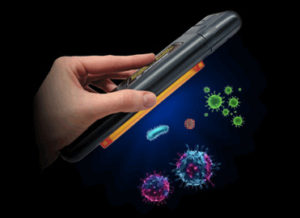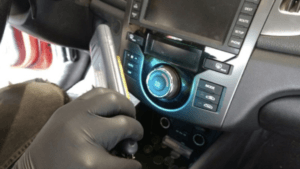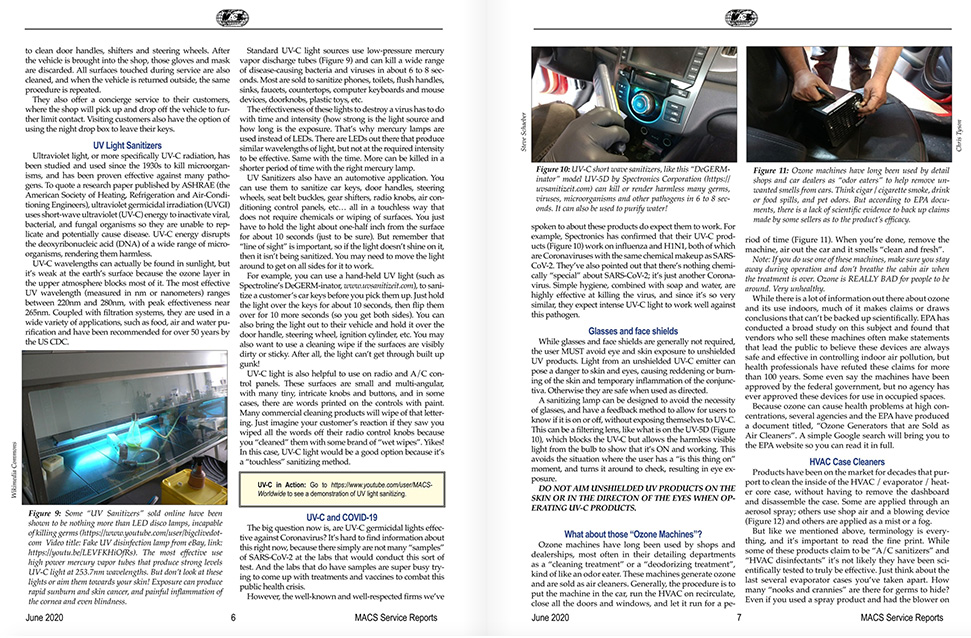The Mobile Air Conditioning Society (MACS – www.macsw.org) is the leading non-profit trade association for total vehicle climate and thermal management founded in 1981. MACS Worldwide is the recognized global authority on mobile air conditioning and heat transfer industry issues, providing technical training and compliance programs for the mobile air conditioning and heat transfer industry. They also provide a forum for trade information on a regional, national and international basis while informing technicians on legislative and regulatory initiatives within industry. Members of MACS Worldwide have access to monthly MACS Service Reports, their official technical publication intended for the educational use of members of the automotive air conditioning service and repair industry.
the educational use of members of the automotive air conditioning service and repair industry.
The vehicle service and repair industry were defined as essential services by the Federal Government after associations like the Automotive Service Association (ASA) and the Automotive Oil Change Association (AOCA) have called for these facilities be able to remain open during the pandemic. The automotive industry is currently investigating ways to fight viruses, including using ultraviolet light to sanitize car interiors, foggers to spray disinfectants, upgrading air filtration systems, and employing antimicrobial materials. A handheld tool, such as The DeGERM-inator™ (UV-5D) can inactivate 90% of most microorganisms in 6-8 seconds by sanitizing areas used in homes and offices, mobile devices, and in automobiles.
Highlights from the MACS June Service Report
Three concerns with vehicle service
Looking closely at vehicle service, there are three areas we’re most concerned with:
• Technician safety
• Vehicle cleanliness
• Inside the HVAC Case
First, the technician needs to safely approach the vehicle and perform some type of sanitizing (which includes the door handles, steering wheel, shifter handle, seat belt buckles, ignition keys and ignition switch) prior to bringing the vehicle into the shop for service. This protects the technician from surface contamination that may be present on the vehicle and should be performed while wearing PPE (personal protective equipment) like gloves, goggles or a face shield, and a face mask or respirator.
 Second there is a concern with the general cleanliness of the vehicle’s interior. As people drive their cars they are talking and breathing, and sometimes droplets are expelled from their mouths onto the dashboard and other instrument panel and interior surfaces. Also, if an occupant is sick, they could possibly sneeze inside the vehicle, expelling contaminated droplets onto interior surfaces. This goes beyond those which are required to be touched to drive into the shop, and include things like radio control knobs, A/C dashboard controls, vent outlets, seat cushions and sun visors, as well as any personal items the customer may have left inside the vehicle.
Second there is a concern with the general cleanliness of the vehicle’s interior. As people drive their cars they are talking and breathing, and sometimes droplets are expelled from their mouths onto the dashboard and other instrument panel and interior surfaces. Also, if an occupant is sick, they could possibly sneeze inside the vehicle, expelling contaminated droplets onto interior surfaces. This goes beyond those which are required to be touched to drive into the shop, and include things like radio control knobs, A/C dashboard controls, vent outlets, seat cushions and sun visors, as well as any personal items the customer may have left inside the vehicle.
Third there is the HVAC case itself, particularly the condition of the interior duct work surfaces, cabin air filter, blower motor fins and squirrel cage, blend doors, and the fins and plates of the heater core(s) and evaporator(s). Especially if a vehicle’s HVAC system is operated in recirculation mode, there is the possibility of bioaerosols being carried along with the recirculating air, into the air intake ducts, and onto the cabin air filter.
UV Light Sanitizers
Ultraviolet light, or more specifically UV-C radiation, has been studied and used since the 1930s to kill micro organisms, and has been proven effective against many pathogens. To quote a research paper published by ASHRAE (the American Society of Heating, Refrigeration and Air-Conditioning Engineers), ultraviolet germicidal irradiation (UVGI) uses short-wave ultraviolet (UV-C) energy to inactivate viral, bacterial, and fungal organisms so they are unable to replicate and potentially cause disease. UV-C energy disrupts the deoxyribonucleic acid (DNA) of a wide range of micro-organisms, rendering them harmless.
UV-C wavelengths can actually be found in sunlight, but it’s weak at the earth’s surface because the ozone layer in the upper atmosphere blocks most of it. The most effective UV wavelength (measured in nm or nanometers) ranges between 220nm and 280nm, with peak effectiveness near 265nm. Coupled with filtration systems, they are used in a wide variety of applications, such as food, air and water purification and have been recommended for over 50 years by the US CDC.
Standard UV-C light sources use low-pressure mercury vapor discharge tubes (Figure 9) and can kill a wide range of disease-causing bacteria and viruses in about 6 to 8 seconds. Most are sold to sanitize phones, toilets, flush handles, sinks, faucets, countertops, computer keyboards and mouse devices, doorknobs, plastic toys, etc.
The effectiveness of these lights to destroy a virus has to do with time and intensity (how strong is the light source and how long is the exposure. That’s why mercury lamps are used instead of LEDs. There are LEDs out there that produce similar wavelengths of light, but not at the required intensity to be effective. Same with the time. More can be killed in a shorter period of time with the right mercury lamp.
UV Sanitizers also have an automotive application. You can use them to sanitize car keys, door handles, steering wheels, seat belt buckles, gear shifters, radio knobs, air conditioning control panels, etc… all in a touchless way that does not require chemicals or wiping of surfaces. You just have to hold the light about one-half inch from the surface for about 10 seconds.
Here is a direct link to the MACS service report: https://www.nxtbook.com/nxtbooks/macs/servicereports_2020/index.php#/p/JUN6



